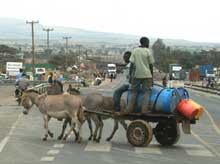This past August, Jill and I spent nearly three weeks in Kenya, visiting our daughter and son-in-law, who were working there with the US State Department. Generally considered a developing nation, Kenya has a long and interesting history, which involves, not surprisingly, the automobile.
Kenya’s British colonial heritage dictates that traffic keep to the left. While there are recently-built good roads, others are in poor shape and the transition between the two is often abrupt. Maintenance is frequently casual, and building of new roads can seem illogical and usually involves much manual labor. Traffic is less disciplined than we are used to, and departures from the established lanes are common, which results in vehicles coming from unexpected directions. In rural areas, one must watch for animals on the road. Even on main routes, animal traffic is often encountered, and bicycles, too, carry cargo.
Roadsides in Kenya provide a nationwide marketplace, where one can buy fruit and vegetables, furniture, pottery or plants. That’s not to say the country lacks mercantile infrastructure. The Nakumatt chain is the Kenyan equivalent of Super Wal-Mart and Best Buy rolled into one. There is no domestic oil, so all petroleum products are trucked in from elsewhere.
The car of choice in East Africa was formerly the Peugeot, and examples of 404s, 504s and 505s are still seen on the roads. However, the most popular car is now the Toyota Corolla, most often a station wagon and almost invariably white. A few upscale, even American, cars can be seen, but luxury SUVs, like in the States, rarely go off-road. There’s a good parts network and numerous, if primitive, facilities for fixing cars, although the vast majority of repairs seem to be carried out at the side of the road.
Few Kenyans, however, have cars of their own and must rely on buses or matatus. The latter, (whose name means “for three” in Swahili, as originally the fare was three ten-shilling coins – now about 35 cents). are 14-passenger minivans (nearly all Toyota HiAce vans) that ply established routes and make frequent stops. They operate erratically and are frequently overloaded, and the careful motorist will give them wide berth. Only in Nakuru, the principal city in central Kenya, did we encounter scooter taxis, known as “tuk-tuks,” and real freeway-style highways.
School buses are nothing like those in the United States, but it came as a surprise to see a bus-like hearse. It seems that since few people have cars and many burials are conducted in the deceased’s home village, the family and other mourners ride with the coffin on its homeward journey. Moreover, most towns have a convenient coffin shop.
While Kenya can be seen as a throwback to the motoring past, it also provides a glimpse into our future. While we were driving in Nairobi I spotted my first Chery Tiggo. Chinese cars may be coming to America, but they are already very much in Africa.

